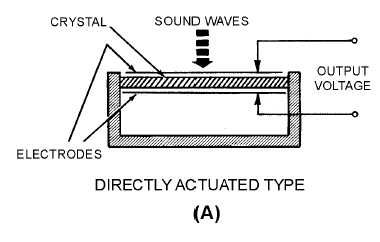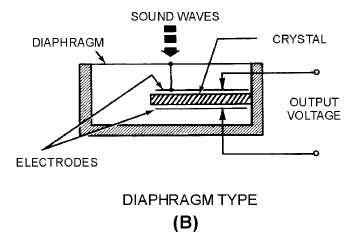1-39
One disadvantage of carbon microphones is that of a constant BACKGROUND HISS (hissing noise)
which results from random changes in the resistance between individual carbon granules. Other
disadvantages are reduced sensitivity and distortion that may result from the granules packing or sticking
together. The carbon microphone also has a limited frequency response. Still another disadvantage is a
requirement for an external voltage source.
The disadvantages, however, are offset by advantages that make its use in military applications
widespread. It is lightweight, rugged, and can produce an extremely high output.
CRYSTAL MICROPHONE.—The CRYSTAL MICROPHONE uses the PIEZOELECTRIC
EFFECT of Rochelle salt, quartz, or other crystalline materials. This means that when mechanical stress is
placed upon the material, a voltage electromagnetic force (EMF) is generated. Since Rochelle salt has the
largest voltage output for a given mechanical stress, it is the most commonly used crystal in microphones.
View (A) of figure 1-34 is a crystal microphone in which the crystal is mounted so that the sound waves
strike it directly. View (B) has a diaphragm that is mechanically linked to the crystal so that the sound
waves are indirectly coupled to the crystal.
Figure 1-34A.—Crystal microphones.
Figure 1-34B.—Crystal microphones.



